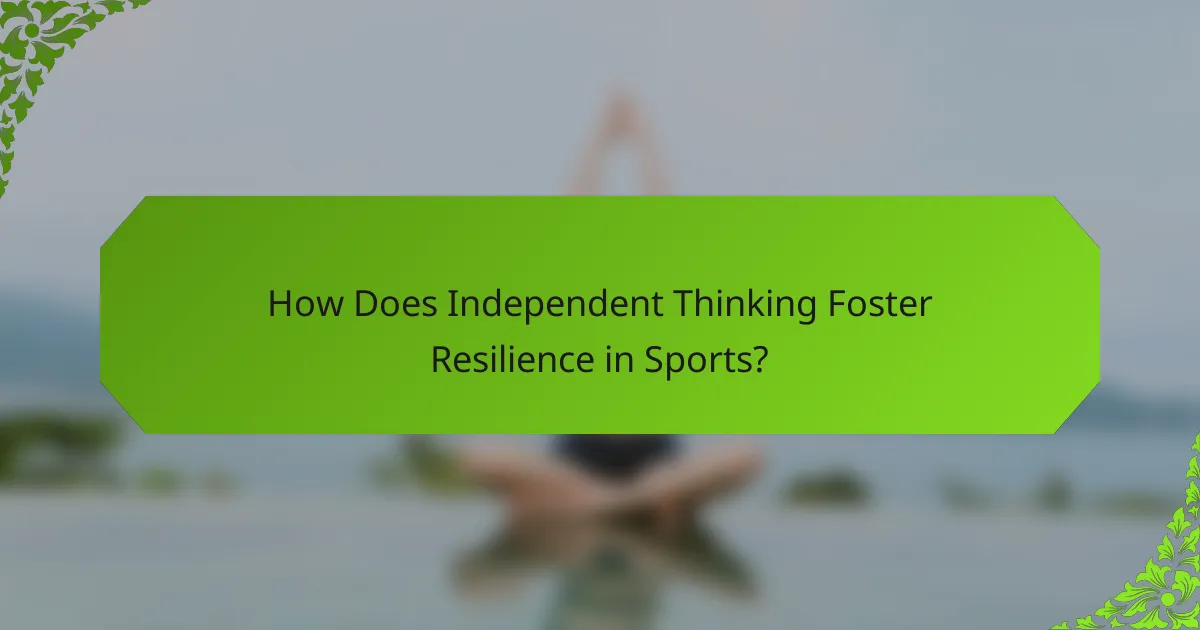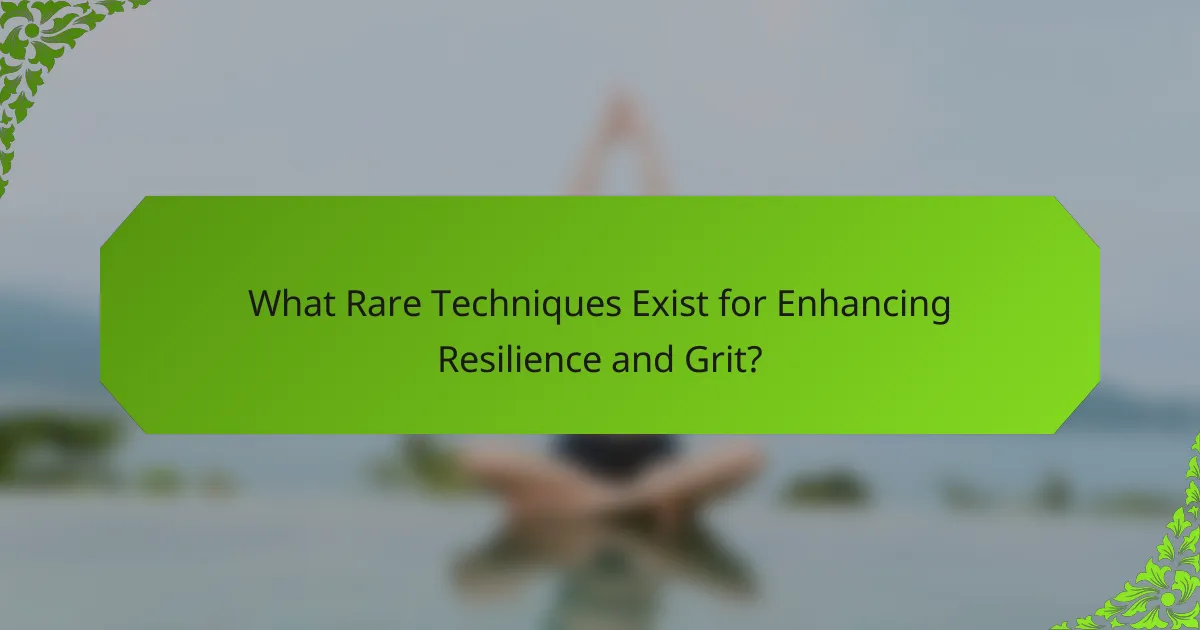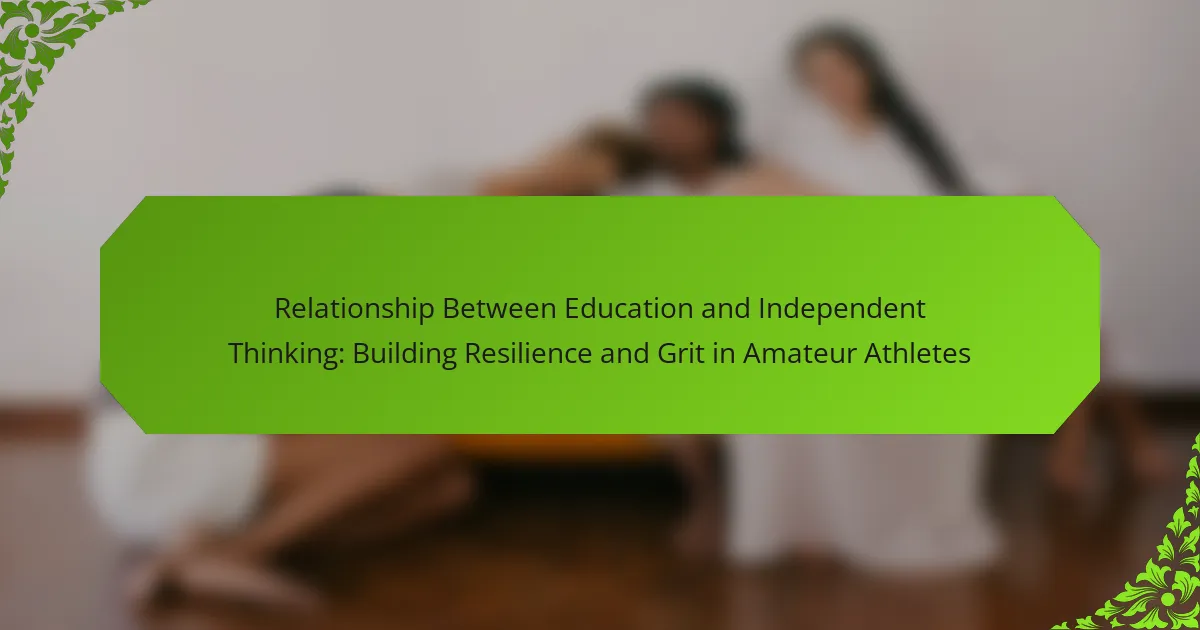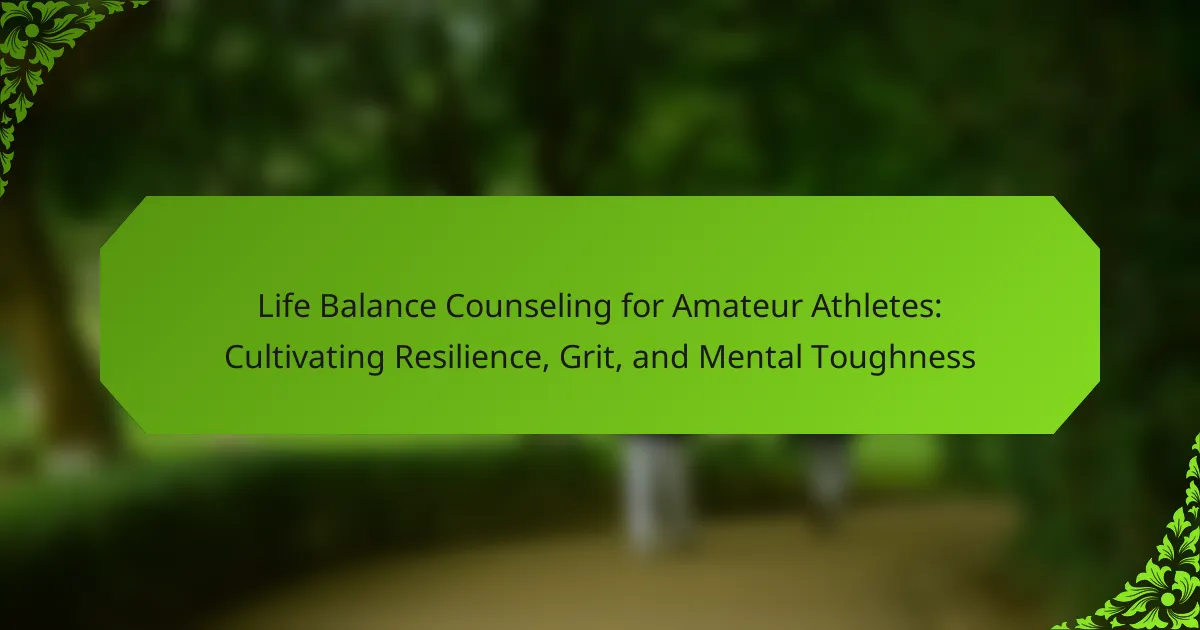Building resilience and grit is crucial for amateur athletes facing challenges in sports. Education equips them with critical thinking and problem-solving skills. Independent thinking fosters adaptability and mental toughness. This article explores how these elements contribute to an athlete’s performance and enjoyment of their sport.

What is the Role of Education in Developing Resilience and Grit?
Education fosters resilience and grit by teaching amateur athletes critical thinking and problem-solving skills. It encourages self-discipline and perseverance, essential for overcoming challenges. Structured learning environments provide opportunities for athletes to face setbacks, learn from failures, and develop coping strategies. Research shows that athletes with strong educational backgrounds exhibit higher levels of grit, as they are trained to approach obstacles with a growth mindset. This combination of education and independent thinking enhances their ability to adapt and thrive in competitive sports.
How Does Traditional Education Impact Amateur Athletes?
Traditional education can enhance amateur athletes’ resilience and grit by fostering critical thinking and problem-solving skills. Educational settings encourage discipline, time management, and adaptability, essential traits for overcoming challenges in sports. As a result, athletes develop a mindset that embraces setbacks as learning opportunities, which contributes to their overall performance. Studies show that athletes with strong educational backgrounds often exhibit better emotional regulation and decision-making on and off the field. This unique attribute of education helps cultivate a balanced approach to competition and personal growth.
What Are the Limitations of Formal Education in Building Grit?
Formal education often limits the development of grit in amateur athletes by emphasizing rote learning over experiential challenges. This traditional approach can neglect the unique attributes of independent thinking and resilience necessary for overcoming obstacles in sports. For instance, structured environments may not provide sufficient opportunities for athletes to confront failure and adapt. As a result, athletes may struggle to cultivate the perseverance needed to excel in competitive scenarios. Moreover, the focus on grades can overshadow the importance of intrinsic motivation and self-directed learning, which are critical for building resilience.

How Does Independent Thinking Foster Resilience in Sports?
Independent thinking enhances resilience in sports by fostering adaptability and problem-solving skills. Athletes who cultivate independent thought can effectively navigate challenges and setbacks. This mindset encourages them to learn from failures, promoting grit and perseverance. Research shows that athletes with strong independent thinking skills demonstrate higher levels of mental toughness, enabling them to overcome obstacles and maintain focus during competitions. By prioritizing independent thought, amateur athletes build a robust foundation for resilience, ultimately improving their performance and enjoyment of the sport.
What Strategies Promote Independent Thinking Among Amateur Athletes?
Encouraging independent thinking among amateur athletes involves fostering resilience and grit through specific strategies. These include promoting self-reflection, encouraging goal-setting, and offering opportunities for decision-making.
Self-reflection allows athletes to evaluate their performance and learn from experiences. Goal-setting helps athletes establish personal benchmarks, enhancing motivation and accountability. Opportunities for decision-making empower athletes to take ownership of their training and competition, reinforcing their ability to think independently.
Additionally, mentorship programs can provide guidance while allowing athletes to explore their unique paths. Engaging in team discussions encourages diverse perspectives, enhancing critical thinking skills.
Finally, incorporating challenges that require problem-solving can build resilience, preparing athletes to face adversity with confidence. These strategies collectively promote independent thinking, essential for personal and athletic growth.
How Can Goal Setting Enhance Independent Thinking?
Goal setting enhances independent thinking by fostering self-discipline and accountability. It encourages amateur athletes to take ownership of their training and decision-making processes. This autonomy builds resilience, as athletes learn to navigate challenges and setbacks independently. Furthermore, setting specific, measurable goals cultivates grit, motivating athletes to persist through difficulties. By aligning personal aspirations with actionable steps, goal setting transforms abstract ambitions into tangible achievements, reinforcing a mindset of self-reliance and critical thinking.
What Role Does Self-Reflection Play in Developing Grit?
Self-reflection is crucial for developing grit as it fosters self-awareness and resilience. By evaluating experiences, athletes identify strengths and weaknesses, which enhances their ability to persevere through challenges. This process builds mental toughness, enabling them to maintain focus on long-term goals despite setbacks. Regular self-reflection also encourages a growth mindset, reinforcing the belief that effort leads to improvement. Consequently, athletes become more adaptable and committed, vital components of grit.

What Are the Universal Practices for Building Resilience in Athletes?
Building resilience in athletes involves cultivating mental toughness, adaptability, and a growth mindset. Key practices include setting realistic goals, fostering a supportive environment, and encouraging self-reflection.
1. Goal Setting: Establish clear, achievable objectives to enhance motivation and focus.
2. Support Systems: Create a network of coaches, peers, and mentors to provide guidance and encouragement.
3. Self-Reflection: Encourage athletes to analyze their experiences, learn from setbacks, and celebrate successes.
4. Stress Management: Teach techniques such as mindfulness and visualization to cope with pressure.
5. Adaptability: Promote flexibility in training and competition strategies to handle unexpected challenges.
6. Grit Development: Focus on perseverance and passion for long-term goals, reinforcing dedication and hard work.
Which Mental Techniques Are Commonly Used to Enhance Grit?
Mental techniques commonly used to enhance grit include visualization, positive self-talk, and goal-setting. Visualization helps athletes mentally rehearse success, fostering resilience. Positive self-talk reinforces belief in abilities, which is crucial during challenges. Goal-setting provides structure and motivation, enabling athletes to track progress and maintain focus.
How Can Physical Training Contribute to Mental Resilience?
Physical training significantly enhances mental resilience by promoting discipline and focus. Engaging in consistent physical activity fosters grit, as athletes learn to push through discomfort and setbacks. This process builds a robust mindset, essential for overcoming challenges in both sports and life. Research indicates that athletes who train regularly exhibit higher levels of emotional regulation and stress management. As a result, they develop a unique ability to maintain composure under pressure, which translates to improved performance and decision-making.

What Unique Approaches Can Athletes Use to Cultivate Grit?
Amateur athletes can cultivate grit through unique approaches like goal-setting, self-reflection, and embracing challenges. Setting specific, measurable goals fosters determination. Self-reflection enhances awareness of progress and setbacks. Embracing challenges builds resilience and adaptability, reinforcing the grit needed for long-term success.
How Does Mindset Shift Influence Performance Outcomes?
A mindset shift significantly enhances performance outcomes by fostering resilience and grit in amateur athletes. This shift encourages independent thinking, enabling athletes to adapt to challenges and setbacks effectively. Research indicates that athletes with a growth mindset demonstrate improved perseverance and motivation, leading to better performance metrics. For instance, a study found that athletes who embraced challenges were 30% more likely to achieve personal bests compared to those with a fixed mindset. By cultivating an adaptive mindset, athletes can transform obstacles into opportunities for growth, ultimately enhancing their competitive edge.
What Unique Challenges Do Amateur Athletes Face in Developing Resilience?
Amateur athletes face unique challenges in developing resilience, including limited resources, inconsistent coaching, and pressure to balance training with other commitments. These factors can hinder their mental toughness and grit. For example, many amateur athletes lack access to professional support systems that enhance resilience, such as sports psychologists or nutritionists. As a result, they must often rely on self-directed strategies to cultivate perseverance and adaptability. Additionally, the fear of failure can be pronounced in amateur athletes, impacting their ability to take risks and learn from setbacks.

What Rare Techniques Exist for Enhancing Resilience and Grit?
Mindfulness practices enhance resilience and grit in amateur athletes. Techniques such as visualization, breath control, and positive self-talk cultivate mental strength. Research shows that these methods improve focus and emotional regulation. Integrating them into training routines fosters a growth mindset, essential for overcoming challenges.
Are There Lesser-Known Practices That Can Boost Grit?
Yes, lesser-known practices can enhance grit in amateur athletes. Techniques such as mindfulness meditation, visualization, and deliberate practice cultivate mental resilience. Mindfulness improves focus and reduces anxiety, while visualization aids in goal setting. Deliberate practice emphasizes targeted skill improvement, fostering persistence. Engaging in these practices consistently can significantly boost an athlete’s grit over time.
How Can Coaches Encourage Unique Resilience Strategies?
Coaches can encourage unique resilience strategies by fostering an environment that values independent thinking. This approach empowers amateur athletes to develop grit through personalized problem-solving experiences. By incorporating tailored challenges and reflective practices, coaches can help athletes identify their strengths and weaknesses, leading to adaptive resilience. Additionally, promoting a growth mindset encourages athletes to view setbacks as opportunities for learning, enhancing their overall mental toughness.

What Common Mistakes Do Athletes Make in Their Resilience Journey?
Athletes often make mistakes in their resilience journey by relying too heavily on external validation and neglecting self-reflection. Common pitfalls include setting unrealistic expectations, underestimating the importance of mental training, and failing to adapt strategies based on personal experiences. These errors hinder the development of grit and independent thinking, which are essential for long-term success.
How Can Athletes Avoid Over-Reliance on Education Alone?
Athletes can avoid over-reliance on education by cultivating independent thinking skills. This involves actively engaging in problem-solving, seeking diverse experiences, and reflecting on personal challenges. Emphasizing resilience and grit allows athletes to adapt and thrive beyond academic knowledge. Engaging in real-world scenarios fosters critical thinking, enabling athletes to make informed decisions under pressure. This approach enhances their ability to navigate obstacles and develop a proactive mindset essential for success in sports.
What Are the Best Practices for Balancing Education and Independent Thinking?
Balancing education and independent thinking in amateur athletes fosters resilience and grit. Prioritize experiential learning, encourage critical questioning, and provide opportunities for self-directed practice. Integrate structured education with real-world challenges to enhance adaptability. Promote a growth mindset to help athletes embrace setbacks as learning experiences.

How Can Amateur Athletes Implement Resilience and Grit Practices Today?
Amateur athletes can implement resilience and grit practices today by focusing on mental training and consistent self-reflection. Engaging in daily goal-setting and embracing challenges fosters a growth mindset. Incorporating visualization techniques enhances performance under pressure. Additionally, seeking feedback and learning from failures builds adaptability. These practices cultivate a strong foundation for resilience and grit.
What Immediate Actions Can Athletes Take to Build Grit?
Athletes can build grit through immediate actions such as setting specific goals, embracing challenges, and maintaining a positive mindset. These strategies foster resilience and enhance their ability to overcome obstacles.
1. Set clear, achievable goals to provide direction and motivation.
2. Embrace challenges by stepping outside comfort zones to develop perseverance.
3. Cultivate a positive mindset by focusing on progress and learning from setbacks.
4. Practice self-discipline through consistent training and routines.
5. Seek feedback and mentorship to enhance learning and growth.
6. Reflect regularly on experiences to build self-awareness and resilience.
How Can Support Systems Enhance Resilience in Amateur Sports?
Support systems significantly enhance resilience in amateur sports by providing emotional, social, and practical support. These systems foster a sense of belonging, which is crucial for athletes facing challenges. For example, coaches and teammates can offer encouragement during tough times, helping athletes develop grit. Research indicates that athletes with strong support networks are more likely to persevere through setbacks, indicating a direct link between support and resilience. Additionally, mentorship from experienced athletes can impart valuable strategies for overcoming adversity, further reinforcing resilience.



